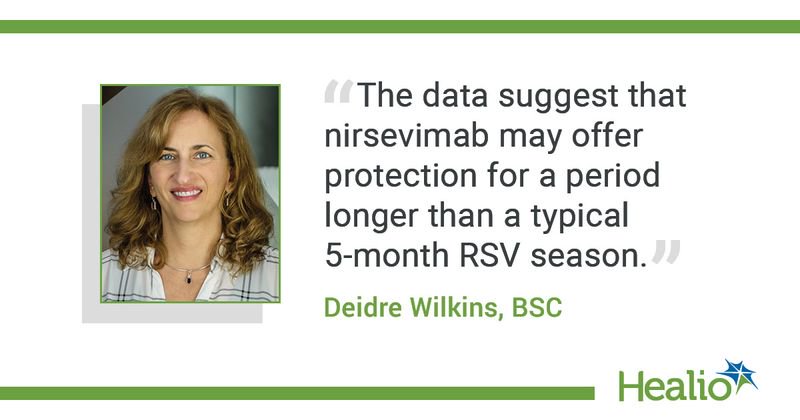Protection from nirsevimab may last longer than an RSV season
Click Here to Manage Email Alerts
Key takeaways:
- Nirsevimab may offer protection for a period longer than a typical 5-month RSV season.
- Further investigation is needed on the duration of protection in this population.
Nirsevimab, a monoclonal antibody recently approved to prevent respiratory syncytial virus-associated lower respiratory disease in newborns and infants, may protect longer than an RSV season, researchers reported at IDWeek.
In August, the CDC recommended nirsevimab (Beyfortus, AstraZeneca and Sanofi) as an intramuscular injection of 50 mg for infants with a body weight less than 5 kg and 100 mg for infants with a body weight of 5 kg or more.

Children aged 8 to 19 months who are entering their second RSV season and are at an increased risk for severe RSV disease are recommended to receive one dose at 200 mg.
The data presented at IDWeek were from AstraZeneca and Sanofi’s Phase 2/3 MEDLEY trial.
“Nirsevimab is the first preventive option approved by the FDA that is specifically designed to protect the broad infant population through its first RSV season,” Deidre Wilkins, BSC, director of translational scientific management for AstraZeneca’s vaccines and immune therapies unit, told Healio.
MEDLEY measured the safety and pharmacokinetics of nirsevimab compared with the monoclonal antibody palivizumab among infants born at 35 weeks’ gestational age or younger or with congenital heart disease (CHD) and chronic lung disease (CLD).
“In MEDLEY, neutralizing antibodies were measured as an exploratory endpoint. This presentation demonstrates trends in RSV neutralizing antibodies (nAbs) in participants dosed with nirsevimab or Synagis,” Wilkins explained.
Wilkins and colleagues studied a cohort of 612 preterm infants and 306 infants with CHD. Control patients received palivizumab — “the standard of care for RSV prevention for 25 years for infants born preterm or with CLD or CHD,” Wilkins said.
“As an exploratory endpoint, we compared RSV nAbs in patients treated with nirsevimab or palivizumab,” Wilkins said. “Based on principles of pharmacokinetics modeling, we can use measured nirsevimab concentrations to extrapolate efficacy in a high-risk infant population. Nirsevimab and palivizumab serum concentrations were correlated with serum RSV neutralizing antibody levels.”
According to the researchers, RSV nAbs for nirsevimab were around 10-fold higher than for palivizumab after 151 days, and nirsevimab nAbs were sustained through 1 year after dosing.
Wilkins said the results were as expected.
“The analysis showed that nirsevimab is associated with higher and more sustained levels of RSV nAbs compared with” palivizumab, Wilkins said. “The data suggest that nirsevimab may offer protection for a period longer than a typical 5-month RSV season.”
She added that the data reflected nirsevimab’s ability to address as-yet-unmet needs in ill infants who require RSV protection.
“As the first preventive option specifically designed to protect the broad infant population through its first RSV season, including those born healthy at term or preterm, or with specific health conditions, nirsevimab addresses a critical 60-year unmet need for protection against RSV disease,” Wilkins said. “Nirsevimab demonstrates high and sustained levels of neutralizing antibodies and suggests protection could extend beyond 5 months. Further investigation is warranted on the duration of protection that nirsevimab offers to all infants, particularly the most vulnerable populations such as CLD/CHD subgroups.”

